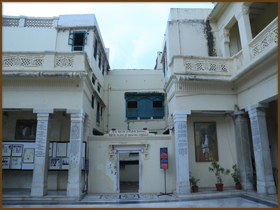Gandhi Heritage Sites - Writeups
You are here
Kirti Mandir, Porbandar

Connection with Gandhiji
It is the ancestral home of Gandhiji where he was born as Mohan. It consists of two parts: birthplace-ancestral home and a monument built later.
Ancestors
Gandhiji’s great grandfather Shri Harjeevan Rahidas Gandhi had purchased this house. His grandfather Uttamchand Gandhi, alias Ota Gandhi ‘must have been a man of principle’ wrote Gandhiji in his autobiography. Among his six sons from two marriages, Karamchand alias Kaba Gandhi was the fifth and Tulsidas Gandhi was the youngest. Kaba Gandhi was diwan- prime minister of Porbandar state. Tulsidas Gandhi assumed the same position later on.
According to Gandhiji, ‘Kaba Gandhi married four times in succession having lost his wife each time by death. He had two daughters by his first and second marriage. His last wife, Putlibai, bore him a daughter and three sons.’ Gandhiji was the youngest.- The Story of My Experiments with Truth: p. 11
Ancestral Home
Gandhiji’s great grandfather Shri Harjeevan Rahidas Gandhi had purchased this house from Maanbai Gangaji Mehta in 1777. Gandhiji’s grandfather, Uttamchand Gandhi added a floor to the house. Later another floor was also added.
Memories of Mohan
• Gandhiji spends the first seven years of his childhood, from October 1869 to November 1876 at Porbandar before shifting to Rajkot along with the family.
• His parents called him ‘Moniyo’ or ‘Manu’.
• He entered a Gujarati School in Porbandar in1875.
• He got engaged with Kasturbai Kapadia, daughter of Gokuldas and Vrajkunwar of Porbandar in 1876, as per customs of those days. It was his third engagement. In the previous two engagements, both the girls died, reflecting the high rate of child mortality at that time.
Brief History of the Memorial
During his visit to Panchgani in June 1945, Gandhiji stayed at Nanjibhai Kalidas Mehta’s bungalow ‘Dilkhush’. Mehta, a prominent businessman from Porbandar along with Maharaja Natwarsinh, the ruler of Porbandar, informed Gandhiji that they wished to construct a memorial in his honour at Porbandar.
Gandhiji authorised Maneklal Amrutlal Gandhi (his cousin’s son) to sell the ancestral house to Nanjibhai Kalidas Mehta who in turn purchased the house from all the members of the Gandhi family. Maneklal Gandhi’s grandfather Tulsidas Gandhi was the brother of Karamchand Gandhi.
- CWMG Vol. 83: p. 188
In addition to this building, Mehta acquired some neighbouring houses and land and began planning to construct a suitable memorial. Kirti Mandir was designed and built by the renowned architect Purushottambhai Mistry. Its cornerstone was laid by veteran freedom fighter and Gandhiji’s associate Darbar Gopaldas Desai in the year 1947. The construction was completed in two years.
Kirti Mandir was dedicated to the nation on May 27, 1950 by Sardar Vallabhbhai Patel.
Present Structure
Gandhiji’s birthplace has three rooms on the ground floor: a room where Gandhiji was born, a living room, and a kitchen. The first floor consists of a living room, a guest room, a kitchen, and a dining area. On the second floor, there is a study, guest room, living room, and prayer room.
At Kirti Mandir, the ground floor has an exhibition (museum), a memorial place, and a library. The first floor houses a photo gallery.
The building has a courtyard. There is an underground tank beneath the courtyard for the storage of water. The cover of the tank can be seen in the verandah. The courtyard has been built on a three-frame- structure above this large tank.
Digital Experience
Virtual Tour | Audio Guide App (Android) | Audio Guide App (iOS) | Architectural Documents
Site Address
Kirti Mandir
Kasturba Gandhi Marg,
Porbandar, Gujarat, India – 360 575
Contact
Archaeological Survey Of India
Vadodara Circle,
Puratattva Bhavan,
near Central Library,
Mandvi,
Vadodara, Gujarat, India – 390 006
Website: https://asi.nic.in/
Additional Details
1. More on Gandhiji’s parents and childhood in Porbandar from his autobiography.
2. More on Gandhiji’s ancestors from Prabhudas Gandhi’s book ‘My Childhood with Gandhiji’ Chapters 1 to 3.

Copyright Information
Gandhi Heritage Portal by Sabarmati Ashram Preservation and Memorial Trust is licensed under Creative Commons Attribution-NonCommercial-NoDerivatives 4.0 International